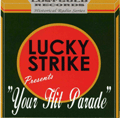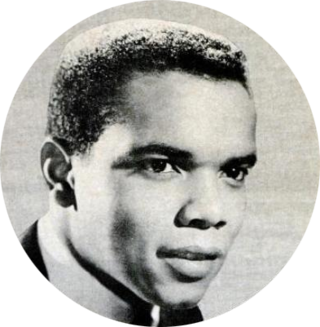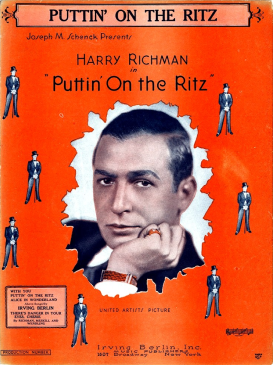Payola, in the music industry, is the illegal practice of paying a commercial radio station to play a song without the station disclosing the payment. Under US law, a radio station must disclose songs they were paid to play on the air as sponsored airtime. The number of times the songs are played can influence the perceived popularity of a song, and payola may be used to influence these meters. The Federal Communications Commission (FCC) treats payola as a violation of the Sponsorship Identification Rules, which requires any broadcast of paid material to include a disclosure.

Your Hit Parade was an American radio and television music program that was broadcast from 1935 to 1953 on radio, and seen from 1950 to 1959 on television. It was sponsored by American Tobacco's Lucky Strike cigarettes. During its 24-year run, the show had 19 orchestra leaders and 52 singers or groups. Many fans inaccurately referred to the show as The Hit Parade.
In the music industry, the Top 40 is the current, 40 most-popular songs in a particular genre. It is the best-selling or most frequently broadcast popular music. Record charts have traditionally consisted of a total of 40 songs. "Top 40" or "contemporary hit radio" is also a radio format. Frequent variants of the Top 40 are the Top 10, Top 20, Top 30, Top 50, Top 75, Top 100 and Top 200.

John Lester Nash Jr. was an American singer-songwriter, best known in the United States for his 1972 hit "I Can See Clearly Now". Primarily a reggae and pop singer, he was one of the first non-Jamaican artists to record reggae music in Kingston.

American Top 40 is an internationally syndicated, independent song countdown radio program created by Casey Kasem, Don Bustany, Tom Rounds, and Ron Jacobs. The program is currently hosted by Ryan Seacrest and presented as an adjunct to his weekday radio program, On Air with Ryan Seacrest.
Bill Drake, born Philip Yarbrough, was an American radio programmer who co-developed the Boss Radio format with Gene Chenault via their company Drake-Chenault.

WMCA is a radio station licensed to New York, New York. Owned by Salem Media Group, the station programs a Christian radio format consisting of teaching and talk programs. The station's studios are in lower Manhattan and are shared with co-owned WNYM. WMCA's transmitter is located along Belleville Turnpike in Kearny, New Jersey. WMCA's programming is simulcast on a 250 watt translator, W272DX, from a tower in Clifton, New Jersey.

"Puttin' On the Ritz" is a song written by Irving Berlin. He wrote it in May 1927 and first published it on December 2, 1929. It was registered as an unpublished song August 24, 1927 and again on July 27, 1928. It was introduced by Harry Richman and chorus in the musical film Puttin' On the Ritz (1930). According to The Complete Lyrics of Irving Berlin, this was the first song in film to be sung by an interracial ensemble. The title derives from the slang expression "to put on the Ritz", meaning to dress very fashionably. This expression was in turn inspired by the opulent Ritz Hotel in London.
The Billboard charts tabulate the relative weekly popularity of songs and albums in the United States and elsewhere. The results are published in Billboard magazine. Billboard biz, the online extension of the Billboard charts, provides additional weekly charts, as well as year-end charts. The two most important charts are the Billboard Hot 100 for songs and Billboard 200 for albums, and other charts may be dedicated to a specific genre such as R&B, country, or rock, or they may cover all genres. The charts can be ranked according to sales, streams, or airplay, and for main song charts such as the Hot 100 song chart, all three data are used to compile the charts. For the Billboard 200 album chart, streams and track sales are included in addition to album sales.
Contemporary hit radio is a radio format that is common in many countries that focuses on playing current and recurrent popular music as determined by the Top 40 music charts. There are several subcategories, dominantly focusing on rock, pop, or urban music. Used alone, CHR most often refers to the CHR-pop format. The term contemporary hit radio was coined in the early 1980s by Radio & Records magazine to designate Top 40 stations which continued to play hits from all musical genres as pop music splintered into Adult contemporary, Urban contemporary, Contemporary Christian and other formats.
Robert Todd Storz headed a very successful chain of American radio broadcasting stations and is generally credited with being the foremost innovator of the Top 40 radio format in 1951. The selection of records to be played was based on sales reported by record stores, an indication as to which would be of greatest interest to listeners. Only the favorites would be played, in rotation. Some sources also credit his Omaha radio station as among the first to play at least some rock and roll records.
American Country Countdown, also known as ACC, is a weekly internationally syndicated radio program which counts down the top 40 country songs of the previous week, from No. 40 to No. 1, according to the Billboard Country Airplay chart. The program premiered in 1973 and as of January 2006 is hosted by Kix Brooks. It is syndicated by Cumulus Media Networks.

WFLY is a Top 40/CHR radio station licensed to Troy, New York, and serving the Capital District. The station is owned by Pamal Broadcasting and is considered the company's flagship station. The radio studios and offices are at 6 Johnson Road in Latham.
The CHUM Chart was a ranking of top 30 songs on Toronto, Ontario radio station CHUM AM, from 1957 to 1986, and was the longest-running Top 40 chart in the world produced by an individual radio station. On January 10, 1998, sister station CHUM-FM, which airs a hot adult contemporary format, revived the CHUM Chart name for a new countdown show.

Edward R. Salamon is an American entertainment industry executive and radio broadcaster. He is credited as one of the people who led to country music becoming a major force in the mid-1990s. He was dubbed “country radio’s most influential programmer” while programming WHN, New York, which became the most listened to country radio station of all time in the mid-1970s, an accomplishment that led to his induction into the Country Radio Seminar Hall of Fame in 2006.

Dorothy Collins was a Canadian-American singer, actress, and recording artist.
The year 1972 in radio involved some significant events.

John Harlan Rook was an American radio programmer and executive, most known for his tenure in Chicago. Under his guidance in the 1960s, 50,000-watt ABC-owned WLS became the highest rated station in the Chicago metropolitan area, known as one of the greatest Top 40 stations in America. After leaving WLS to form a radio consultancy in 1970, WLS' rival, WCFL-AM, beat WLS in the ratings after retaining Rook's services. Throughout his programming career, Rook won numerous national radio awards and was repeatedly singled out for his ability to pick hit records. He would later own his own radio stations before founding the Hit Parade Hall of Fame, the only foundation that bestows awards on popular performers based upon the votes of the general public.
"There! I've Said It Again" is a popular song written and published by Redd Evans and David Mann in 1941. In early 1945, Vaughn Monroe and his Orchestra released Victor 20-1637, which reached the number one position on the Billboard's National Radio Airplay chart for five straight weeks, then no.2 for six more weeks, and a total run of 29 weeks. It finished 1945 as the no. 4 record of the year.

Joan Edwards was an American film actress and singer-songwriter in the old-time radio era. She was perhaps best known for her work on the radio version of Your Hit Parade. She also was a vocalist for Paul Whiteman and his Orchestra.









